 W
WIn Greek mythology, Alcmene or Alcmena was the wife of Amphitryon by whom she bore two children, Iphicles and Laonome. She is best known as the mother of Heracles, whose father was the god Zeus. Alcmene was also referred to as Electryone (Ἠλεκτρυώνην), a patronymic name as a daughter of Electryon.
 W
WIn Greek mythology, Alcyoneus or Alkyoneus was a traditional opponent of the hero Heracles. He was usually considered to be one of the Gigantes (Giants), the offspring of Gaia born from the blood of the castrated Uranus.
 W
WIn Greek mythology, the Amazons are portrayed in a number of ancient epic poems and legends, such as the Labours of Hercules, the Argonautica and the Iliad. They were a group of female warriors and hunters, who matched men in physical agility and strength, in archery, riding skills and the arts of combat. Their society was closed for men and they only raised their daughters, either killing their sons or returning them to their fathers, with whom they would only socialize briefly in order to reproduce.
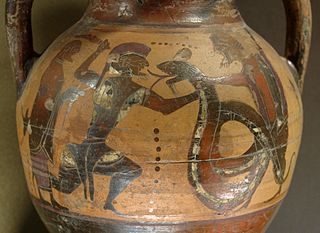 W
WAmphitryon, in Greek mythology, was a son of Alcaeus, king of Tiryns in Argolis. His mother was named either Astydameia, the daughter of Pelops and Hippodamia, or Laonome, daughter of Guneus, or else Hipponome, daughter of Menoeceus. Amphitryon was the brother of Anaxo, and Perimede, wife of Licymnius. He was a husband of Alcmene, Electryon's daughter, and stepfather of the Greek hero Heracles.
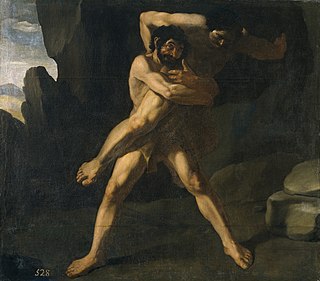 W
WAntaeus, known to the Berbers as Anti, was a figure in Berber and Greek mythology. He was famed for his defeat by Heracles as part of the Labours of Hercules.
 W
WArchaies Kleones is a settlement in the municipality of Nemea, Corinthia, Greece with a population of 1092 residents according to 2011 census. It is situated on a hillside, 15 km east of Nemea and 18 km southwest of Corinth.
 W
WIn Greek mythology, Atlas is a Titan condemned to hold up the heavens or sky for eternity after the Titanomachy. Atlas also plays a role in the myths of two of the greatest Greek heroes: Heracles and Perseus. According to the ancient Greek poet Hesiod, Atlas stood at the ends of the earth in extreme west. Later, he became commonly identified with the Atlas Mountains in northwest Africa and was said to be the first King of Mauretania. Atlas was said to have been skilled in philosophy, mathematics, and astronomy. In antiquity, he was credited with inventing the first celestial sphere. In some texts, he is even credited with the invention of astronomy itself.
 W
WIn Greek mythology, Busiris was an Egyptian king who was killed by Heracles. It may also refer to the Greek name of a place in Egypt, which in Egyptian was named pr-wsjr "Temple of Osiris" but had the civil name of ḏdw. The location was an important necropolis and a centre for the cult of Osiris, hence name Busiris. The word Busiris was also used to refer to chief god of Busiris, an attribute of Osiris.
 W
WIn ancient Roman religion and myth, Caca or Cacia is the giantess sister of Cacus, the son of Vulcan who stole cattle from Hercules during the course of his western labors. Caca betrays her brother by revealing the location of the cattle to Hercules, who had in turn stolen the cattle from Geryon.
 W
WIn Roman mythology, Cacus was a fire-breathing giant and the son of Vulcan. He was killed by Hercules after terrorizing the Aventine Hill before the founding of Rome.
 W
WIn Greek mythology, Cephalus is an Aeolian prince, the son of Deion/ Deioneos, ruler of Phocis, and Diomede, and grandson of Aeolus. He was one of the lovers of the dawn goddess Eos.
 W
WIn Greek mythology, the Cercopes were mischievous forest creatures who lived in Thermopylae or on Euboea but roamed the world and might turn up anywhere mischief was afoot. They were two brothers, but their names are given variously:Passalus (Πάσσαλος) and Acmon (Ἄκμων) or Aclemon Basalas (Βάσαλας) and Achemon (Ἄχημων) Olus (Ὤλος) and Eurybatus (Εὐρύβατος) Candolus (Κάνδωλος) and Atlantus (Ἄτλαντος) Sillus (Σίλλος) and Triballus (Τρίβαλλος)
 W
WIn Greek mythology, Chiron was held to be the superlative centaur amongst his brethren since he was called the "wisest and justest of all the centaurs".
 W
WCithaeron or Kithairon is a mountain and mountain range about ten miles long, in central Greece. The range is the physical boundary between Boeotia in the north and Attica in the south. It is mainly composed of limestone and rises to 1,409 metres (4,623 ft). The north-east side of the range is formed by the mountain Pastra.
 W
WIn Greek mythology, Cycnus or Cygnus, was a bloodthirsty and cruel man who dwelt either in Pagasae, Thessaly or by the river Echedorus in Macedonia.
 W
WIn Greek mythology, King Diomedes of Thrace was the son of Ares and Cyrene. He lived on the shores of the Black Sea ruling the warlike tribe of Bistones. He is known for his man-eating horses, which Heracles stole in order to complete the eighth of his Twelve Labours, slaying Diomedes in the process.
 W
WDionysus is the god of the grape-harvest, winemaking and wine, of fertility, orchards and fruit, vegetation, insanity, ritual madness, religious ecstasy, festivity and theatre in ancient Greek religion and myth.
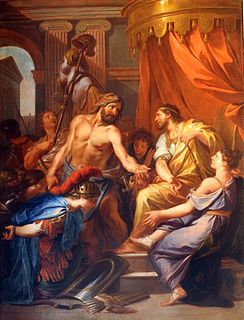 W
WIn Greek mythology, Eurystheus was king of Tiryns, one of three Mycenaean strongholds in the Argolid, although other authors including Homer and Euripides cast him as ruler of Argos.
 W
WIn Greek mythology King Eurytus of Oechalia, Thessaly, was a skillful archer who even said to have instructed Heracles in his art of using the bow.
 W
WIn Greek mythology, Galanthis or Galinthias was the woman who interfered with Hera's plan to hinder the birth of Heracles in favor of Eurystheus, and was changed into a weasel or cat as punishment for being so insolent as to deceive the goddesses of birth that were acting on Hera's behalf.
 W
WIn Greek and Roman Mythology, the Giants, also called Gigantes, were a race of great strength and aggression, though not necessarily of great size. They were known for the Gigantomachy, their battle with the Olympian gods. According to Hesiod, the Giants were the offspring of Gaia (Earth), born from the blood that fell when Uranus (Sky) was castrated by his Titan son Cronus.
 W
WHera is the goddess of women, marriage, family and childbirth in ancient Greek religion and mythology, one of the twelve Olympians and the sister and wife of Zeus. She is the daughter of the Titans Cronus and Rhea. Hera rules over Mount Olympus as queen of the gods. A matronly figure, Hera served as both the patroness and protectress of married women, presiding over weddings and blessing marital unions. One of Hera's defining characteristics is her jealous and vengeful nature against Zeus' numerous lovers and illegitimate offspring, as well as the mortals who cross her.
 W
WHeracles, born Alcaeus or Alcides, was a divine hero in Greek mythology, the son of Zeus and Alcmene, and the foster son of Amphitryon. He was a great-grandson and half-brother of Perseus. He was the greatest of the Greek heroes, the ancestor of royal clans who claimed to be Heracleidae (Ἡρακλεῖδαι), and a champion of the Olympian order against chthonic monsters. In Rome and the modern West, he is known as Hercules, with whom the later Roman emperors, in particular Commodus and Maximian, often identified themselves. The Romans adopted the Greek version of his life and works essentially unchanged, but added anecdotal detail of their own, some of it linking the hero with the geography of the Central Mediterranean. Details of his cult were adapted to Rome as well.
 W
WHercules at the crossroads, also known as the Choice of Hercules and the Judgement of Hercules, is an ancient Greek parable attributed to Prodicus and known from Xenophon. It concerns the young Heracles/Hercules who is offered a choice between Vice and Virtue—a life of pleasure or one of hardship and honour. In the early modern period it became a popular motif in Western art.
 W
WIn Greek mythology and later art, the name Hesione refers to various mythological figures, of whom the Trojan princess Hesione is most known.
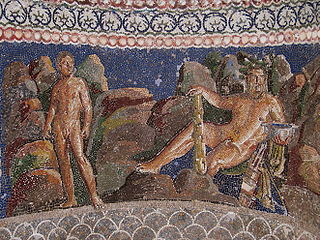 W
WIn Greek mythology, Iolaus was a Theban divine hero, son of Iphicles and Automedusa.
 W
WIn Greek mythology, Iphicles, also called Iphiclus, was the fraternal twin half-brother of Heracles and one of the Calydonian boar hunters.
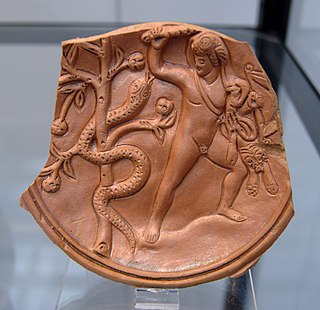 W
WLadon was a monster in Greek mythology.
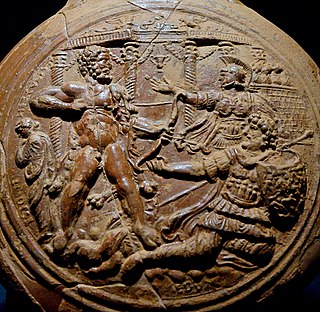 W
WIn Greek mythology, Laomedon was a Trojan king, son of Ilus and thus nephew of Ganymede and Assaracus.
 W
WIn Greek mythology, Lichas was Heracles' servant, who brought the poisoned shirt from Deianira to Hercules because of Deianira's jealousy of Iole, which killed him.
 W
WMount Oeta is a mountain in Central Greece. A southeastern offshoot of the Pindus range, it is 2,152 m (7,060 ft) high. Since 1966, the core area of the mountain is a national park, and much of the rest has been declared a special area under Natura 2000.
 W
WIn Greek mythology, Nereus was the eldest son of Gaia and of her son, Pontus. Nereus and Doris became the parents of 50 daughters and a son (Nerites), with whom Nereus lived in the Aegean Sea.
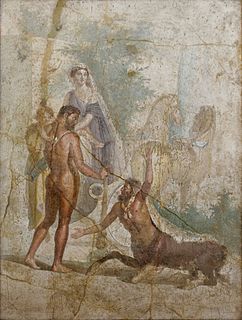 W
WIn Greek mythology, Nessus was a famous centaur who was killed by Heracles, and whose poisoned blood in turn killed Heracles. He was the son of Centauros. He fought in the battle with the Lapiths and became a ferryman on the river Euenos.
 W
WNestor of Gerenia was the legendary wise King of Pylos described in Homer's Odyssey. Excavations from 1939 revealed his palace, and excavations have recently resumed at the site.
 W
WIn Greek mythology, Orthrus or Orthus was, according to the mythographer Apollodorus, a two-headed dog who guarded Geryon's cattle and was killed by Heracles. He was the offspring of the monsters Echidna and Typhon, and the brother of Cerberus, who was also a multi-headed guard dog.
 W
WPhiloctetes, or Philocthetes, according to Greek mythology, was the son of Poeas, king of Meliboea in Thessaly, and Demonassa or Methone. He was a Greek hero, famed as an archer, and a participant in the Trojan War.
 W
WIn Greek mythology, Pholus was a wise centaur and friend of Heracles who lived in a cave on or near Mount Pelion.
 W
WThe Pillars of Hercules was the phrase that was applied in Antiquity to the promontories that flank the entrance to the Strait of Gibraltar. The northern Pillar, Calpe Mons, is the Rock of Gibraltar. A corresponding North African peak not being predominant, the identity of the southern Pillar, Abila Mons, has been disputed throughout history, with the two most likely candidates being Monte Hacho in Ceuta and Jebel Musa in Morocco.
 W
WPirithous, in Greek mythology, was the King of the Lapiths of Larissa in Thessaly, as well as best friend to Theseus.
 W
WIn Greek mythology, Porphyrion was one of the Gigantes (Giants), who according to Hesiod, were the offspring of Gaia, born from the blood that fell when Uranus (Sky) was castrated by their son Cronus. In some other versions of the myth, the Gigantes were born of Gaia and Tartarus.
 W
WIn Greek mythology, Priam was the legendary king of Troy during the Trojan War. His many children included notable characters like Hector and Paris.
 W
WIn Greek mythology, Prometheus is a Titan god of fire. Prometheus is credited with the creation of humanity from clay, and of defying the gods by stealing fire and giving it to humanity as civilization. Prometheus is known for his intelligence and for being a champion of humankind, and is also generally seen as the author of the human arts and sciences. He is sometimes presented as the father of Deucalion, the hero of the flood story.
 W
WIn Greek mythology, the Shirt of Nessus, Tunic of Nessus, Nessus-robe, or Nessus' shirt was the poisoned shirt that killed Heracles. It was once a popular reference in literature. In folkloristics, it is considered an instance of the "poison dress" motif.
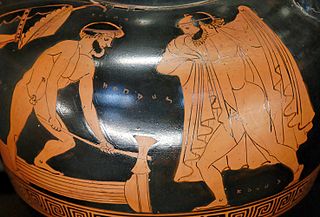 W
WIn Greek mythology, Syleus was a man of Aulis, Lydia killed by Heracles for his nefarious deeds. He was the father of Xenodoce.
 W
WIn Greek mythology, Thanatos was the personification of death. He was a minor figure in Greek mythology, often referred to but rarely appearing in person.
 W
WThebe Hypoplakia, also Cilician Thebe, was a city in ancient Anatolia. Alternative names include Placia, Hypoplacia and Hypoplacian Thebe(s), referring to the city's position at the foot of Mount Placus. Near the local village "Tepeoba".
 W
WIn Greek mythology and religion, the thiasus, was the ecstatic retinue of Dionysus, often pictured as inebriated revelers. Many of the myths of Dionysus are connected with his arrival in the form of a procession. The grandest such version was his triumphant return from "India", which influenced symbolic conceptions of the Roman triumph and was narrated in rapturous detail in Nonnus' Dionysiaca. In this procession, Dionysus rides a chariot, often drawn by big cats such as tigers, leopards, or lions.
 W
WIn Greek mythology, Tyndareus was a Spartan king.
 W
WXenoclea, who appears as a character in the legend of Hercules, was the Pythia, or priestess and oracle, of the temple of Apollo at Delphi.